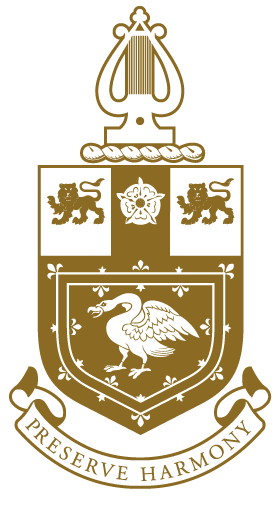Music in Schools: Richard Cobden Primary School Pictures at an Exhibition Project (Camden 2022)

Young Artists Hannah Williams (horn) and Esther Beyer (harp) at Richard Cobden Primary School in 2022, working on our Pictures at an Exhibition Composition project
Mussorgsky’s most famous work, Pictures at an Exhibition, was the theme for a recent project at Richard Cobden Primary School in Camden. Delivered by Young Artist Esther Beyer (harpist) and Hannah Williams (French horn), the 9-week project set out to help Year 2 and 3 pupils explore how pictures relate to music. Esther tells us more about this feel-good Musicians’ Company project.
“Even with the best lesson plan in the world you still need to think on your feet. This became strikingly clear as Hannah, my partner on this workshop, and I stepped up to take the lead on a participation project last winter for the very first time.
We began our first in-class session using our harp and horn to play works from Mussorgysky’s Pictures at an Exhibition, a ten-movement piano suite considered one of the finest examples of the link between music and art. We then introduced ourselves, our own instruments and their sounds. Following warm-ups, Hannah played Madsen’s Dream Of The Rhinoceros on the horn, sparking a conversation about what the rhinoceros might be thinking. I then played a piece called Celestial Spirals by Lauren Scott, linking the sounds of my folk harp to colour through a series of celestial images.
Having introduced the pupils to how music and art intertwine, we set about helping the pupils create compositions based on famous works of art. Working in small groups, Hannah, Lis – one of the school music teachers – and I encouraged the pupils to use percussion to consider the painting’s emotional energy and to use their instruments to shake, drum, rattle and ring their responses to each. We split our imagery into easy, medium and difficult, choosing simpler pictures such as Munch’s The Scream for the Year 2s, and more abstract artists such as Turner’s A Storm (Shipwreck) for the Year 3s.
What can you see in the picture? How does it make you feel? Is the scene busy, calm, loud, quiet? What colours can you see? What sounds could we make to show this?
The children’s responses to the paintings were often imaginative. One picture we shared depicted a man sat on a beach looking sad which we thought would lead them to explore ‘sad’ noises. Instead, the pupils got fixated on a woman in a white dress in the far distance which led them to make wedding bell sounds using metallophones. In a group exploring Gogh’s “Starry Night”, a pupil created an amazing tale about a world in darkness because of a wizard’s curse. The group then created a soundtrack to accompany the tale.
Of course, you have to be careful every pupil has a say. While you don’t want to silence the really engaged ones, you also need to bring the quieter ones into the conversation without putting them on the spot. Hannah and I also learnt that it was better not to get out the percussion instruments too early on in a session. Hiding them until we needed the instruments helped us maintain their focus and have a bit of control over the energy within the room.
Just as Mussorgsky’s Pictures of an Exhibition is linked by a promenade theme, with the composer strolling around a gallery to look at each picture, so too was our final performance. With limited space for our audience of younger pupils to stroll around the school hall, the audience sat in the middle of the room twizzling around as each group shared their paintings and composition. In between each presentation Hannah and I played Mussorgsky’s promenade piece hopefully adding to the charm!
This was a great project to get involved in both personally and professionally. Stepping up to lead a project gave me an enormous confidence boost. It’s so rewarding to be able to connect your instrument to others on such a human level. Many young people haven’t touched a horn or harp. Through this project and my other community and participation work with the RAM Open Academy it’s also helped me build my improvisation skills. If a child or even adult with learning disabilities or dementia asks you to play a sound or a song you can do it in the moment and there’s nothing better than that.”
Many thanks to Esther, Hannah, Lis and Company volunteer David for bringing this project to fruition!
Interview by Suzy Willmott
Suzy is freelance copywriter who works with the Musicians’ Company





